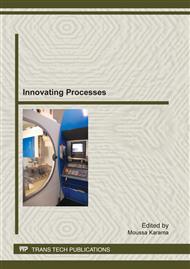[1]
S. Tobias and W. Fishwick: Theory of regenerative machine tool chatter. Engineer 205 (1958), pp. : 199–203 238–239.
Google Scholar
[2]
Y. Altintas and E. Budak: Analytical prediction of stability lobes in milling. Annals of the CIRP 44 (1995), p.357–362.
DOI: 10.1016/s0007-8506(07)62342-7
Google Scholar
[3]
T. Insperger and G. Stépán: Uptaded semi-discretization method for periodic delay-differential equations with discrete delay. International Journal for Numerical Methods in Engineering 61 (2004), p.117–141.
DOI: 10.1002/nme.1061
Google Scholar
[4]
S.D. Merdol and Y. Altintas: Multi frequency solution of chatter stability for low immersion milling. Transactions of the ASME, Journal of Manufacturing Science and Engineering 126 (2004), p.459–466.
DOI: 10.1115/1.1765139
Google Scholar
[5]
B.P. Mann, T. Insperger, G. Stépán and P.V. Bayly: Stability of up-milling and down-milling, part 2 : experimental verification. International Journal of Machine Tools and Manufacture 43 (2003), p.35–40.
DOI: 10.1016/s0890-6955(02)00160-8
Google Scholar
[6]
S. Smith and J. Tlusty: Efficient simulation programs for chatter in milling. Annals of the CIRP 42 (1993), p.463–466.
DOI: 10.1016/s0007-8506(07)62486-x
Google Scholar
[7]
L. Arnaud, O. Gonzalo, S. Seguy, H. Jauregi and G. Peigné: Simulation of low rigidity part machining applied to thin walled structures. International Journal of Advanced Manufacturing Technology 54 (2011), p.479–488.
DOI: 10.1007/s00170-010-2976-9
Google Scholar
[8]
M.L. Campomanes and Y. Altintas: An improved time domain simulation for dynamic milling at small radial immersions. Transactions of the ASME, Journal of Manufacturing Science and Engineering 125 (2003), p.416–422.
DOI: 10.1115/1.1580852
Google Scholar
[9]
G. Peigné, H. Paris, D. Brissaud and A. Gouskov: Impact of the cutting dynamics of small radial immersion milling operations on machined surface roughness. International Journal of Machine Tools and Manufacture 44 (2004), p.1133–1142.
DOI: 10.1016/j.ijmachtools.2004.04.012
Google Scholar
[10]
H. Bleuler, M. Cole, P. Keogh, R. Larsonneur, E. Malsen, R. Nordmann, Y. Okada, G. Schweitzer and A. Traxler: Magnetic bearings, theory, design, and application to rotating machinery. Springer (2009).
DOI: 10.1007/978-3-642-00497-1_13
Google Scholar
[11]
A. Chiba, T. Fukao, O. Ichikawa, M. Oshima, M. Takemoto and D. Dorrell: Magnetic bearings and bearingless drives. Elsevier (2005).
DOI: 10.1016/b978-075065727-3/50000-6
Google Scholar
[12]
N.C. Tsai and R. M Lee: Regulation of spindle position by magnetic actuator array. International Journal of Advanced Manufacturing Technology 53 (2011), p.93–104.
DOI: 10.1007/s00170-010-2830-0
Google Scholar
[13]
C. Knospe: Active magnetic bearings for machining applications. Control Engineering Practice, 15 (2007), p.307–313.
DOI: 10.1016/j.conengprac.2005.12.002
Google Scholar
[14]
S. Auchet, P. Chevrier, M. Lacour and P. Lipinski: A new method of cutting force measurement based on command voltages of active electro-magnetic bearings. International Journal of Machine Tools and Manufacture 44 (2004), p.1441–1449.
DOI: 10.1016/j.ijmachtools.2004.05.009
Google Scholar
[15]
M. Chen and C. R. Knospe: Control approaches to the suppression of machining chatter using active magnetic bearings. Control Systems Technology, IEEE Transactions 15 (2007), p.220–232.
DOI: 10.1109/tcst.2006.886419
Google Scholar
[16]
J.H. Kyung and C.W. Lee: Controller design for a magnetically suspended milling spindle based on chatter stability analysis. JSME International Journal Series C-Mechanical Systems Machine Elements and Manufacturing 46 (2003), p.416–422.
DOI: 10.1299/jsmec.46.416
Google Scholar
[17]
P. Bogacki and L.F. Shampine: A 3(2) pair of Runge-Kutta formulas. Applied Mathematics Letters 2 (1989), p.321–325.
DOI: 10.1016/0893-9659(89)90079-7
Google Scholar


